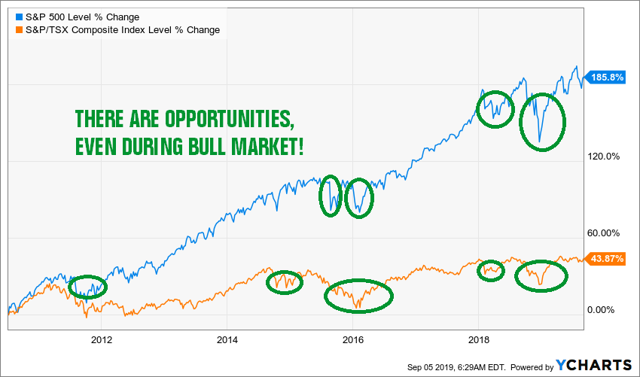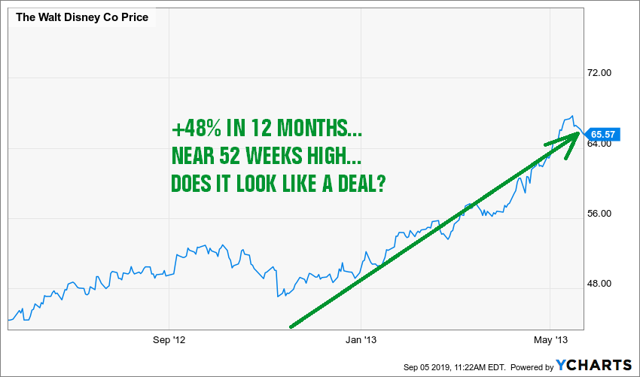Why I Don't Keep Cash And Invest It All by The Dividend Guy
Summary
- The rationale behind keeping cash is easy to understand; buy low, sell high.
- Why I ignore this strategy and don't keep cash.
- Money works for me, not the other way around.
- This idea was discussed in more depth with members of my private investing community, Dividend Growth Rocks.
"Opportunity is missed by most people because it is dressed in overalls and looks like work." -Thomas Edison
Mike, you should keep dry powder (cash) ready. Cash in your portfolio is ready to be deployed when there is an opportunity. Keeping liquidity will make sure you're ready when the market crashes.
Each time I discuss investing "now" on this blog, I get served with the same soup. Keep cash to invest later. Depending on investors, this strategy implies keeping from 5% to 50% of their portfolio on the sidelines. While some "extreme" investors keep up to 100% in cash, my wild guess is most investors probably find a 10-30% of their portfolio being liquid acceptable.
I'm part of the other "extreme" investors who keep 0% to 3% in cash. I invest it all, all the time.
Why do they keep cash?
The rationale behind keeping cash is easy to understand; buy low, sell high. When the market goes down and you have money, you invest and grab shares of great companies at a fraction of the price. It's the equivalent of waiting to buy a new TV until it's Black Friday. You wait the whole year and you grab the best deal on the market. When you look at both the Canadian and US stock markets over the past 10 years, you can see that, even during a strong bull market, there are times to invest at cheaper prices:

Source: YCharts
Buying stocks when they are down 10%, 20%, or 30% seems like you made the deal of the day. It feels good. It generates a (false) impression of security. After all, if you buy shares of 3M (NYSE:MMM) at $160 after seeing it at $250 not too long ago, you can't go wrong, right?
Why I ignore this strategy and don't keep cash
A few months ago, I wrote a shocking piece called "I'm going 30% cash". Of course, I didn't go cash. The point of this article was to calculate the outcome of keeping 30% and 50% of my portfolio in cash and invest it at the perfect market bottom. I took a real-life example (with its pros and cons) and ran the math. If you don't want to read the article, here's the conclusion:
"In both cases, the cash option just hurt my portfolio. While I may have felt 'safer' all it did was to take money away from me."
I know this "one-time scenario" shows many flaws. But besides the fact I was right to invest all my money back in 2017, there is a rationale behind being 100% invested all the time.
Money works for me, not the other way around
When you save money aside, but don't invest it, it comes down to working hard and waiting to get rewarded. In 2017, I had a lump sum of money to invest coming from my former employer's pension plan. The whole purpose of this money is to create a safe retirement. The money is even locked in an account I can't even touch today. So, I might as well have this money start working on this retirement plan today instead of sleeping in on the job, right?
I wasn't excited to invest in an all-time high market (I would have preferred receiving this money in 2009!). I knew that I could lose $30,000 within a few months if there was a market correction. I also knew that companies in my portfolio would generate between $2,000 and $3,500 each year in dividend. That is real money being deposited in my investment account. I know, it's not much compared to the $108K I invested, but dividends are the fruit of my money's labors.
If I picked strong companies, sooner or later their stock price will recover. In the meantime, I will reap dividends monthly. I like the thought of knowing my money works for me.
What about putting your money at 2% in a money market fund or the like?
True, my portfolio currently averages a dividend yield of 2.40% (after a portfolio value growth of ~+45%). My "cost" of not leaving that money sleep well would be only 0.40% at this time (but I would have not gotten the 45% growth). I would also have to say goodbye to all dividend growth coming out of my portfolio. The money market won't increase its interest rate each year. Plus, since I'm Canadian, I can't even find a safe investment paying 2%! Ha ha!
A 52-Week High Story… or Two
According to "cash holder" investors, the key is to buy stocks at a "low" price. This totally makes sense on paper. The problem lies in the definition of "low." Let me ask you a question to prove my point:
Would you buy shares of Disney (NYSE:DIS) at ~$65 today?
Since DIS trades around ~$138 at the time of writing this article, you would probably say something like:
Hell yeah! I'll use my cash to load a bunch of shares in my portfolio!
But what if Disney was trading at its 52-week high? Then you would probably tell me to wait until there is a 20-30% drop before entering in a position. I bought shares of DIS on May 23rd 2013 after a 48% ride and at nearly the highest point in the past 52 weeks.

Source: YCharts
Fortunately for me, my investing process doesn't require me to wait or to identify a 20-30% price drop before buying. Disney is part of my triple-digit club. I have more than doubled my money since 2013.

Source: YCharts
After seeing both graphs, you can then determine that the right price to pay for DIS shares was $65 (or lower, duh). This example illustrates how difficult it is to determine what "the right price" is.
There are no such things, because we don't know the future. DIS shares have stumbled (as they did many times between 2015 and 2018) and created better buying opportunities AFTER 2015. The right price was any moment BEFORE 2015. After 2015, it became anyone's game for a while. But chances are you will never be able to pick DIS shares at $65 again (unless they split).
The same story applied to Lockheed Martin (NYSE:LMT) when I bought shares in January of 2014, when LMT was trading at an all-time high:

Source: YCharts
Once again, I'd rather cash my dividend and let the great company do their thing than watching their stock price with a short time horizon. When I bought shares of DIS or LMT, the only thing I bet on was that both companies would continue to do well and in 25 years from now, they will be worth more than today. At that point, picking them up at the perfect and lowest price was little interest to me.
... Read the Full Article On The Dividend Guy's Seeking Alpha Page
Author Bio:

This article was written by The Dividend Guy. A well-known investment author on Seeking Alpha.
Steem Account: @thedividendguy
Twitter: thedividendguy
Steem Account Status: Unclaimed
Are you The Dividend Guy? If so, you have a Steem account that is unclaimed with pending cryptocurrency rewards sitting in it from your content. Your account was reserved by the Steemleo team and is receiving the rewards of all posts syndicated from your content on other sites.
If you want to claim this account and the rewards that it has been collecting, please contact the Steemleo team via twitter or discord to claim the account. You can also view the rewards currently sitting in the account by visiting the wallet page for this account.
What is Steemleo Content Syndication?

The Steemleo team is syndicating high-quality financial content from across the internet. We're also creating free Steem accounts for the authors of that content who have not yet discovered the Steem blockchain as a means to monetizing their content and we're listing those accounts as the 100% beneficiaries to all the rewards. If you want to learn more about Steemleo's content syndication strategy, click here.
태그 작성 가이드라인 준수는 콘텐츠 관리와 글에 대한 접근성을 높이기 위해 반드시 필요한 절차입니다. ( It is an essential step to adhere tags guideline, manage content and make access better to your postings.)
스팀코인판에서 활용 가능한 태그는 크게 [보상태그 / 언어태그/ 주제태그]로 구분할 수 있습니다. 보상태그와 언어태그는 필수입니다.(Tags that can be largely grouped into [Main Community / Language / Topic] in community. The language and topic tags are required.)
(예) 한국어로 작성한 자유 주제 포스팅((E.g) Posting for free topic in English)
👍
~Smartsteem Curation Team
Great write up. I sometimes remove my BTC to fiat. Usually only temporarily. But it's dead money and losing value against deflation and qe.
Posted using Partiko Android
Congratulations @leo.syndication! You have completed the following achievement on the Steem blockchain and have been rewarded with new badge(s) :
You can view your badges on your Steem Board and compare to others on the Steem Ranking
If you no longer want to receive notifications, reply to this comment with the word
STOPVote for @Steemitboard as a witness to get one more award and increased upvotes!